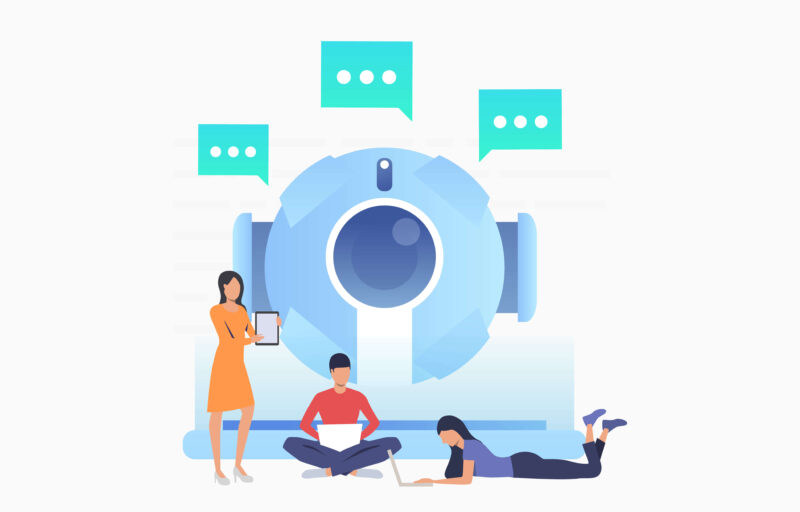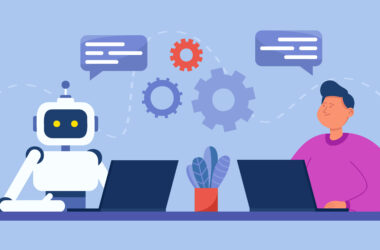Introduction to Chatbots:
If we say that chatbots are changing business operations and customer engagement on a fundamental level, that wouldn’t be wrong! Today, chatbot use cases span various industries and functions, making them a versatile tool for businesses of all sizes.
Businesses use chatbots to meet customer demands and find new paths to success. Advancements in AI make chatbots even more powerful. This increased efficiency cuts costs and boosts productivity, allowing staff to focus on complex tasks.
There are many ways chatbots are becoming better at customer interactions. They excel in customer support, lead generation, and operations, enhancing marketing and sales efforts. They also improve customer satisfaction, reduce costs, and provide valuable insights from collected data.
Nowadays, they do more than answer questions! They make personalized recommendations based on user preferences and history. They seamlessly integrate with voice assistants and virtual reality to create immersive experiences and new avenues for engagement. Let’s look closer at how companies are increasing business efficiency through chatbots!
How Businesses are Using Chatbots?
Incase, you were wondering What are Chatbots Used For? Here it is:
Businesses are using chatbots for a wide range of purposes. From simple customer inquiries to complex business operations, there are many applications of chatbots!
Primarily, they improve customer interactions for businesses. Companies utilize chatbots to provide round-the-clock support, especially for handling urgent queries. This frees human agents for complex issues, which increases efficiency and customer satisfaction.
In sales and marketing, chatbots engage customers, guide sales processes, and collect data. This leads towards targeted promotions, more leads, and higher conversions. In short, for internal operations, chatbots are a boon!
They automate scheduling and manage workflows. They also assist employees, saving time and boosting productivity. Chatbots are proficient in gathering customer data. This data enhances product development and marketing strategies. Here are a few ways in which chatbots are being used:
- In retail, they suggest products and personalized loyalty programs.
- In healthcare, they book appointments and offer support.
- In finance, they help with transactions and answer queries.
- In education, they guide course selection and provide personalized learning.
- In hospitality, they book reservations and provide concierge services.
- In eCommerce, they assist with product search and facilitate purchases.
- In government, they provide citizen support and streamline processes.
- In travel, they offer recommendations and handle bookings.
In fact, future trends point toward AI powered chatbots using natural language processing (NLP). They’re also moving toward augmented and virtual reality integration that will only enhance business operations.
25 Best Chatbots Use Cases for Businesses
AI-powered chatbots have emerged as powerful tools to drive business success. Here are 25 impactful chatbot use cases across industries and functions which we will be discussing below:
- 24/7 Support
- FAQ Automation
- Order Tracking & Assistance
- Returns & Refunds
- Technical Troubleshooting
- Lead Generation & Qualification
- Personalized Product Recommendations
- Run Targeted Promotions & Offers
- Nurture & Educate Leads
- Run Contests & Quizzes
- Employee Onboarding & Training
- IT Help Desk
- Expense Management & Reporting
- Internal Communication & Collaboration
- Meeting & Room Booking
- Product Recommendations & Reviews
- Loyalty Program Management
- Provide Personalized Customer Service
- Run Surveys & Collect Feedback
- Personalized Marketing Outreach
- Healthcare
- Finance
- Travel & Hospitality
- Education
- E-commerce
Customer Service & Support
1) 24/7 Support
These AI powered chatbots are designed to handle various basic inquiries and requests. They enhance customer satisfaction by minimizing wait times and providing prompt assistance. With their round-the-clock availability, they ensure that the customers receive timely support at any time of the day.
They offer faster resolutions and unparalleled support as they deliver exceptional service, even outside regular business hours. That is one of the reasons they are preferred over human customer support professionals. Their ability to assist with precision and speed makes them an invaluable asset to any organization.
2) FAQ Automation
By automating their responses, human agents are freed up to focus on more complex issues. This efficient allocation of resources leads to an improved customer experience. It also ensures that each interaction is handled effectively and promptly.
To engage and reassure readers, chatbots collect data and monitor interactions. This allows them to automate responses or escalate issues promptly. By incorporating these strategies, businesses can streamline their customer support processes.
3) Order Tracking & Assistance
AI-powered chatbots are revolutionizing order tracking and assistance. They can quickly pull up order details and provide real-time updates. This feature reduces customer wait times and minimizes the need to call customer support. They provide real-time updates, answer customer queries, and resolve issues, eliminating the need for human intervention.
Chatbots can also assist in troubleshooting issues and providing resolutions, all without the need for human intervention. This level of automation streamlines order-tracking processes, leading to increased efficiency and productivity.
4) Returns & Refunds
Improve return/refund processes by gathering info and taking action using chatbot chats. Streamlined, efficient, and customer-friendly. Get the details and resolve the issue! No more lengthy procedures that would take up the time of a valued human resource. This chatbot can help enhance customer satisfaction by Instant support.
They can handle the entire process, from gathering customer information to issuing refunds or processing returns. This makes it quick and easy for customers to resolve their issues without going through lengthy procedures=
5) Technical Troubleshooting
For technical troubleshooting, chatbots can diagnose technical problems and provide solutions accordingly. They can also escalate issues to human agents if necessary. This feature allows businesses to handle technical support requests more efficiently and effectively.
It also frees up human agents from handling basic troubleshooting tasks. This enables them to focus on more complex issues and provide prompt resolutions, leading to a better customer experience.
Marketing & Sales
6) Lead Generation & Qualification
With the chatbot applications in lead generation and qualification, you can engage website visitors, qualify leads with questionnaires, and schedule demos or consultations. You can also make the most of pre-made questionnaires to identify potential leads and streamline the process by scheduling demos or consultations. Convert your visitors into valuable leads with interactive engagement while maximizing lead generation efforts and optimizing conversions.
7) Personalized Product Recommendations
Analyze user preferences with these types of chatbots. They suggest products or services that align with individual interests. This tailored approach boosts conversion rates. By understanding what users want, chatbots make relevant recommendations. This not only enhances the user experience but also drives sales. It’s a strategic, efficient way to increase conversions through personalized engagement.
8) Run Targeted Promotions & Offers
You can deliver personalized offers and discounts directly to customers using chatbots. This approach drives sales and boosts satisfaction. Use them to engage with tailored promotions and make your messaging targeted and effective. This leads to higher conversions and increased ROI. Transform marketing with chatbots by offering relevant, exclusive deals.
9) Nurture & Educate Leads
Chatbots offer educational content and answer sales inquiries. They keep leads engaged throughout their decision-making process. This strategy ensures potential customers stay informed and interested. When they’re ready to buy, they have all the necessary information. It’s an effective way to maintain engagement and guide leads towards a purchase.
10) Run Contests & Quizzes
Chatbots can help in brand awareness as well as host interactive contests and quizzes. These activities engage users and gather valuable data. Chatbots make it fun and easy for people to participate. This approach not only entertains but also informs your audience. Collecting user data through these interactions helps improve future marketing efforts. It’s an effective, engaging way to enhance brand visibility.
Internal Operations
11) Employee Onboarding & Training
Chatbot assistants streamline onboarding for new employees. They guide them through processes, answer queries, and offer resources. This digital assistance simplifies the onboarding experience. It ensures newcomers get the information they need quickly and efficiently. Chatbots provide instant, helpful responses, making the transition smoother for new team members. It’s an effective, engaging way to welcome and support new hires.
12) IT Help Desk
Chatbots play a crucial role in supporting employees with basic IT issues. They address common requests, expediting issue resolution and ensuring smooth functioning of IT systems. For more complex problems, chatbots intelligently escalate the matter to the IT team, guaranteeing timely expert intervention. With chatbots as part of the IT support system, organizations effectively manage and optimize their IT infrastructure, maximizing employee productivity and satisfaction.
13) Expense Management & Reporting
Chatbots enable employees to submit expense reports easily. They can also track company finances through simple conversations. This method simplifies financial management. Employees interact with chatbots for quick, accurate expense tracking. It’s a user-friendly, efficient approach to handle financial tasks. They offer a streamlined way to manage and monitor expenses in real-time.
14) Internal Communication & Collaboration
A central chatbot platform enhances communication across departments. It bridges the gap between team members. This single platform allows for seamless, efficient exchanges. Everyone can easily interact and share information. It fosters collaboration and quick responses. This approach streamlines interdepartmental communication, making it more effective and cohesive.
15) Meeting & Room Booking
Chatbots streamline scheduling by managing meetings, booking rooms, and organizing calendars. Interact directly with chatbots for efficient planning. They simplify the process of finding suitable meeting times and spaces. This reduces the hassle of manual scheduling. Chatbots provide a quick, user-friendly way to keep calendars organized. They ensure smooth coordination of appointments and resources in the workplace.
Customer Engagement & Personalization
16) Product Recommendations & Reviews
Chatbots provide personalized product suggestions tailored to user preferences and past purchases. This approach enhances the shopping experience. It makes recommendations more relevant and appealing. Users feel understood and valued with personalization based on purchase history that ensures suggestions are spot-on. This strategy boosts customer satisfaction and loyalty. It’s an effective way to connect users with products they’ll love.
17) Loyalty Program Management
Chatbots efficiently manage loyalty programs. They track reward points and facilitate reward redemption through conversations. This system simplifies loyalty management for users. They easily keep tabs on their points and redeem rewards. Chatbots offer a direct, hassle-free way to engage with loyalty programs. This enhances customer experience and encourages continued participation in the program.
18) Provide Personalized Customer Service
Customize responses and suggestions using each customer’s data and previous interactions. This tailored approach enhances relevance and personalization. It shows customers they are understood and valued. By reflecting individual preferences and history, recommendations become more accurate and appealing. This strategy deepens customer engagement, building stronger, more personalized relationships. It’s a key to effective and meaningful customer interactions.
19) Run Surveys & Collect Feedback
Use chatbots for conducting surveys and gathering customer feedback. Interactive dialogues make this process engaging and efficient. Customers can easily share their thoughts and experiences. This approach provides valuable insights for businesses. It’s a user-friendly way to collect feedback, enhancing customer participation. They turn the task of feedback collection into a smooth, conversational experience using Large Language Models.
20) Personalized Marketing Outreach
Send targeted marketing messages and promotions tailored to customer preferences and demographics. This strategy ensures relevance and personalization. It connects customers with offers that match their interests and backgrounds. Such customization enhances the effectiveness of marketing efforts. Customers receive promotions they are likely to appreciate and respond to. This approach boosts engagement and increases the chances of successful conversions.
Industry-Specific Chatbot Applications
21) Healthcare
Chatbots help schedule appointments and answer medical queries. They offer basic health information and mental health support. This service makes healthcare access easier and quicker. Patients get instant responses to common health questions. This tech also provides mental health guidance, offering support and resources. AI Powered Chatbots are a convenient tool for managing health-related needs, improving patient experience and accessibility.
22) Finance
Chatbots efficiently handle banking tasks. They provide account information, initiate transactions, and answer financial queries. Offering personalized financial advice, these bots cater to individual needs. You can enjoy instant access to their financial details and support. You can use them to simplify managing finances, from checking balances to getting tailored advice. This approach enhances user experience, making financial management convenient and user-friendly.
23) Travel & Hospitality
You can book flights, hotels, tours, and activities with ease using chatbots. They answer travel questions and provide advice. This tool makes trip planning efficient and stress-free. Travelers get quick answers and suggestions, tailored to their preferences. You can also turn to chatbots for the complex task of travel arrangements. They can be a go-to resource for hassle-free travel planning.
24) Education
Chatbots aid students with course enrollments and academic queries. They provide details about campus resources and offer chatbot-powered tutoring. This support streamlines the educational process. Students access course information and get help easily. with enhanced learning thanks to chatbots. They’re a valuable tool for academic guidance, making student life more manageable and productive.
25) Ecommerce
This one’s not a surprise for anyone! Ecommerce has evolved into the big industry that it is today thanks to the enhanced online shopping experience. Chatbots offer personalized product recommendations. They answer product-related questions and support order tracking. This tool makes buying online seamless and informative. Customers get tailored suggestions, making their shopping experience unique. They also streamline the purchase process, providing assistance at every step.
Why Should You Consider Chatbot Development Services?
With the increasing demand and potential for chatbots, businesses are turning to AI powered chatbot development services. These services offer expertise in creating customized chatbots to meet specific business needs.
As more businesses adopt chatbots, the relationship between efficiency, personalization, and customer satisfaction becomes clear. Embrace this digital evolution by partnering with Folio3 AI for expert guidance. We excel in developing and integrating chatbot solutions, steering businesses through digital evolution.
Leverage chatbots to drive innovation and customer-centric approaches! Contact us today to explore how Folio3 AI can drive success for your business.
Frequently Asked Questions (FAQs)
How Can Businesses Benefit from Implementing Chatbots?
Chatbots benefit businesses in multiple ways. They enhance customer satisfaction by providing 24/7 support and resolving issues faster. Chatbots also improve sales and marketing efforts by qualifying leads and offering real-time recommendations.
What Are Some Examples of Chatbots Use Cases Across Different Business Functions?
Generative AI-powered chatbots have the potential to revolutionize business functions across customer service, sales, marketing, HR, and IT support. They can handle multiple queries, provide instant responses, offer product information, collect insights, streamline recruitment, and provide immediate assistance.
How Do Chatbots Contribute to Operational Efficiency in Businesses?
Chatbots are efficient tools that automate tasks, such as FAQs and appointment bookings, freeing up human staff for strategic work. They provide instant support 24/7, prevent bottlenecks, and gather valuable customer data.
What Are the Key Factors to Consider When Selecting Chatbots for Business Applications?
Choosing the right chatbot is crucial for business success. Consider customer needs, identify common areas of contact, and focus on high-volume, low-complexity tasks. Align goals with business objectives and measure success based on key metrics. Also, prioritize high ROI use cases, ensure technical feasibility, and design a user-friendly interface.
Can Chatbots Be Customized for Specific Business Needs?
Chatbots are highly customizable and offer flexibility, scalability, and integration for specific business needs. They provide tailored solutions across various industries like retail, healthcare, finance, and education. Customization improves customer experience, boosts efficiency, enhances data collection, and ensures 24/7 availability.










